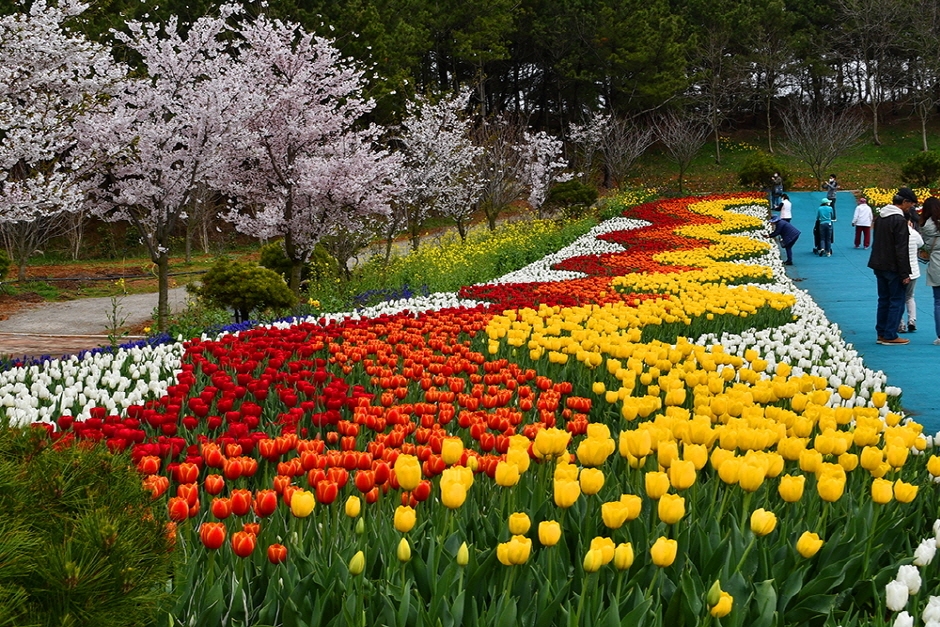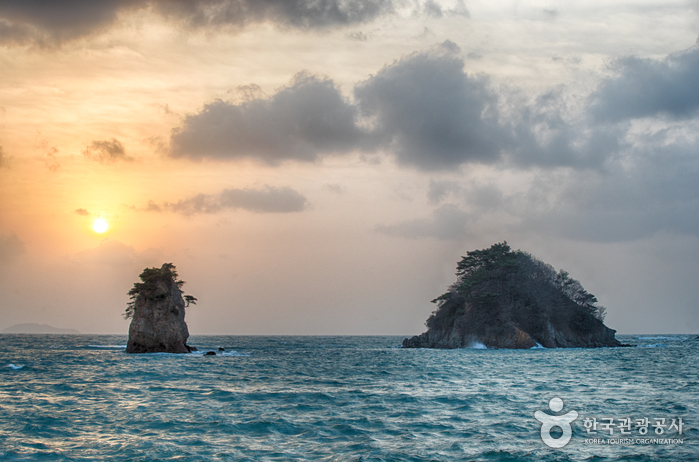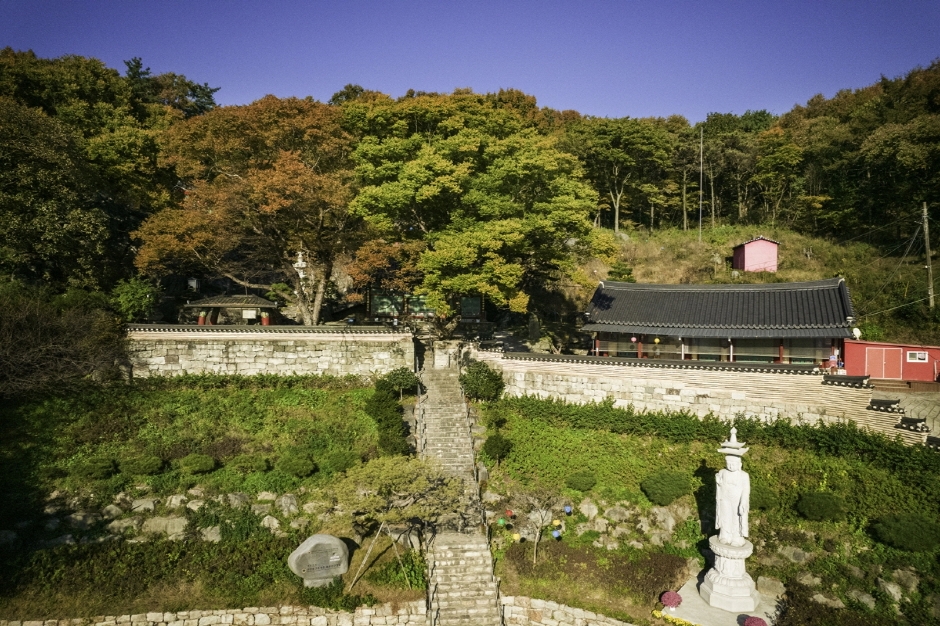Taean Tulip Park (태안 세계튤립꽃박람회)
13.4Km 113622 2024-05-16
400, Kkotjihaean-ro, Taean-gun, Chungcheongnam-do
• 1330 Travel Hotline: +82-2-1330 (Korean, English, Japanese, Chinese) • For more info: +82-41-675-5533
Taean Tulip Park presents the largest flower festival in Korea and offers excellent photo opportunities. The festival venue is divided into sections, which are decorated in different styles according to the annual theme, allowing visitors to enjoy the sight of colorful tulips among creative and fun backdrops.
Bangpo Susan (방포수산)
13.5Km 44369 2024-02-28
64, Bangpohang-gil, Anmyeon-eup, Taean-gun, Chungcheongnam-do
Bangpo Susan serves hoe (sliced raw fish) made with fresh seafood chosen from the massive fish tanks in the shop. One can enjoy a robust meal with a small table charge, particularly the chewy texture of fresh hoe (sliced raw fish) and spicy maeuntang (spicy fish stew). Bangpo Susan is located between Kkotji Beach and Bangpo Port, where one can enjoy fresh hoe (sliced raw fish) with a view of the sea.
Island Resom Oasis Sunset Spa (아일랜드 리솜 오아식스 선셋스파)
13.5Km 26923 2021-06-04
204, Kkotjihaean-ro, Taean-gun, Chungcheongnam-do
+82-41-671-7000
Oasis Sunset Spa is located within Island Resom, an oceanview resort on Anmyeondo Island. The resort features an outdoor infinity pool and five other themed spas. The resort is the perfect venue to enjoy the sunset over Kkotji Beach.
Kkotji Beach (꽃지해수욕장)
13.6Km 25771 2022-07-29
Seungeon-ri, Taean-gun, Chungcheongnam-do
+82-41-670-2691
Kkotji Beach, located in beautiful Anmyeon, features a 5 kilometer stretch of white sand, and attractions like Halbaebawi and Halmaebawi Rocks (Grandpa & Grandma Rocks). Halmaebawi Rock is said to have once been a real woman, Mido, who lived during the Silla period. Her husband was sent on business and never returned. Mido sat by the ocean every day waiting for his return, eventually turning into a stone. Further out to sea, there is a large rock, which naturally earned the nickname of Halbaebawi. Many visitors come to Kkotji Beach all year round to enjoy the beautiful view, and take walks along the beach. The sunset scenery has also become a favorite for photographers.
Haebial Pool Villa [Korea Quality] 해비알풀빌라 [한국관광 품질인증]
13.7Km 0 2023-05-23
29, Bangpo 1-gil, Taean-gun, Chungcheongnam-do
+82-10-5377-4900
Haebial Pool Villa is a pension on Anmyeondo Island, Taean, Chungcheongnam-do. Passing behind the accommodation is Noeul-gil, one of Taean’s famous coastal trails, where guests can take long walks through beautiful coastal woodland; while in front of the pension is Bangpo Beach and the blue West Sea, where guests can enjoy beach life, sea bathing, and spectacular sunsets. There is a convenience store on the first floor.
Bangpo Beach (방포해수욕장)
13.7Km 43813 2024-02-22
29-1 Bangpo 1-gil, Anmyeon-eup, Taean-gun, Chungcheongnam-do
Bangpo Beach, situated on Anmyeondo Island, faces the Yellow Sea and features a gently sloping fine sand shoreline, perfect for both swimming and strolling. It is renowned for housing golden rain trees, designated as a Natural Monument of Korea. Central to the tidal flat are Halmibawi and Harabibawi Rocks. An observatory nearby provides splendid sea views, and Bangpo Port is a source of fresh seafood from the Yellow Sea.
Hongseong Gujeoram Hermitage (구절암(홍성))
14.1Km 20050 2024-01-18
163 Geobuk-ro 218beon-gil, Guhang-myeon, Hongseong-gun, Chungcheongnam-do
Gujeoram Hermitage is located within a bamboo forest on a small mountain. The pathway is winding, without any signs marking the way, but this adds to the charm.
Unyeo Beach (운여해변)
14.3Km 0 2024-02-22
535-57 Jangsampo-ro, Gonam-myeon, Taean-gun, Chungcheongnam-do
Unyeo Beach, located on Anmyeondo Island and facing the Yellow Sea, is characterized by its coastal dune and doksal, walls constructed for trapping fish at low tide, creating picturesque scenery. To the south of the beach, a breakwater adorned with pine trees, transforms into an island-like platform filled with water at high tide, offering stunning views at sunset. The beach welcomes swimmers during the summer season.
Anmyeon Beach (안면 해수욕장)
14.7Km 17968 2021-06-30
Jeongdang-ri, Taean-gun, Chungcheongnam-do
+82-41-670-2691
Anmyeon Beach is a 10-minute drive away from Yeonyukgyo Bridge, located in southern Taean. The way to the beach is led by sceneries of mountains and rice paddies. Upon arrival, the view gets replaced with a wide-open sandy beach with small islets scattered across the ocean. Anmyeon Beach is also a popular site for rock fishing and catching clams and baby crabs at low tide.
Hongseong Jeongamsa Temple (정암사 (홍성))
14.8Km 8355 2021-03-12
652, Oseo-gil, Hongseong-gun, Chungcheongnam-do
+82-41-641-0488
Jeongamsa Temple is a small rural temple situated halfway up Oseosan Mountain. There are few existing records that mention the temple’s beginning. Some suggest that it was built around AD 527 during the 5th year of Baekje King Seongwang’s reign, but there is little evidence to support this theory. The only reference alluding to a specific time is Yeojidoseo ("Detailed Survey of Korean Geography" published during the late Joseon dynasty). It states Jeongamsa Temple's location as on Oseosan Mountain, and Oseosan Mountain being surrounded by Hongsan Mountain and Baegwolsan Mountain and intersected by Hongju, Gyeolseong, and Boryeong. This indicates the temple was recognized in the mid-18th century and around the same time, Garamgo (a book about temples, published in the late 18th century) also states that Jeongamsa Temple is located approximately 11 kilometers to the east of Gyeolseonghyeon. It is still uncertain whether the temple referred to is Jeongamsa Temple on Oseosan Mountain.
Some foundation stones within the temple site measure 70-80 centimeters on each side. These stones indicate that the old Buddhist shrine of Jeongamsa Temple was laid out with five kan (Korean unit of measurement indicating the space between two pilars) at the front and three kan on the side. Future archaeological studies will help identify the true history of Jeongamsa Temple.




 English
English
 한국어
한국어 日本語
日本語 中文(简体)
中文(简体) Deutsch
Deutsch Français
Français Español
Español Русский
Русский